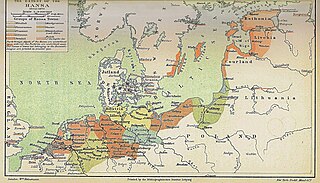| Middle Low German | |
|---|---|
| Sassisch, Dǖdisch, Nedderlendisch, Ôstersch | |
| sassesche sprâke (or unnormalised sassche sprake), nedderlendische sprâke (or unnormalised nederlendesche sprake; since the 16th century)[1] | |
| Region | Northern Central Europe, viz. Northern Germany (roughly the Northern lowlands), Northeastern Netherlands, Northwestern/North-central (modern) Poland, modern Kaliningrad Oblast, also sporadically in Denmark, Sweden, Norway, Latvia, Estonia (confined to cities) |
| Era | 13th to 16th centuries; evolved into Modern Low German; gradually superseded as an official language by High German and (in the far West) Dutch |
Indo-European
| |
Early form | |
| Dialects |
|
| Latin (Fraktur) | |
| Language codes | |
| ISO 639-3 | gml |
| Glottolog | midd1318 |
| Linguasphere | 52-ACB-ca[2] |
 Northern Europe in 1400, showing the extent of the Hanseatic League | |



Middle Low German[a] is a developmental stage of Low German. It developed from the Old Saxon language in the Middle Ages and has been documented in writing since about 1225/34 (Sachsenspiegel). During the Hanseatic period (from about 1300 to about 1600), Middle Low German was the leading written language in the north of Central Europe and served as a lingua franca in the northern half of Europe. It was used parallel to medieval Latin also for purposes of diplomacy and for deeds.[3]
- ^ Lasch, Agathe (1914). Mittelniederdeutsche Grammatik. Halle/Saale: Niemeyer. p. 5.
- ^ "m" (PDF). The Linguasphere Register. p. 219. Archived from the original (PDF) on 27 August 2014. Retrieved 1 March 2013.
- ^ Cordes, Gerhard; Möhn, Dieter (1983). Handbuch zur niederdeutschen Sprach- und Literaturwissenschaft. Erich Schmidt Verlag. p. 119. ISBN 3-503-01645-7.
Cite error: There are <ref group=lower-alpha> tags or {{efn}} templates on this page, but the references will not show without a {{reflist|group=lower-alpha}} template or {{notelist}} template (see the help page).